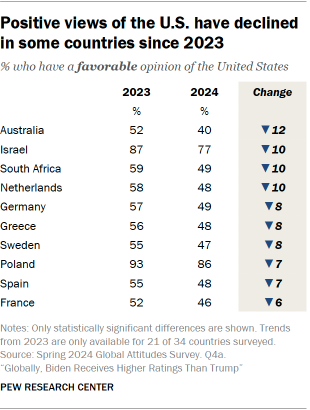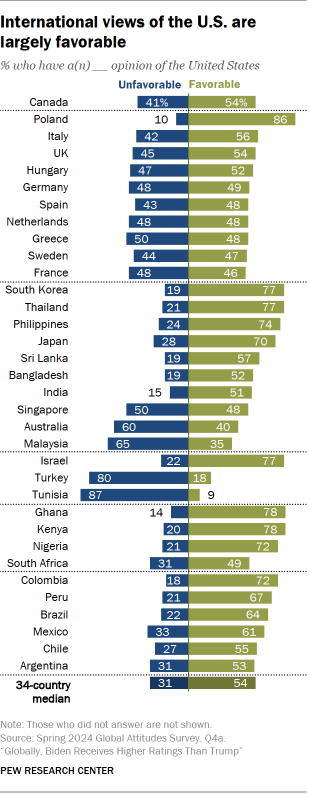Overall, views of the U.S. are more positive than negative across the 34 countries surveyed. A median of 54% hold a favorable opinion of the U.S., while a median of 31% have an unfavorable opinion.
Poles are most likely to evaluate the U.S. positively: 86% hold a favorable view, though this share has declined 7 percentage points since last year. Half or more express a positive view in Hungary, Italy and the UK. In the other European countries surveyed, views of the U.S. are roughly split.
In the Asia-Pacific region, 70% or more rate the U.S. positively in Japan, the Philippines, South Korea and Thailand. In contrast, half or more see the U.S. unfavorably in Australia, Malaysia and Singapore.
The U.S. receives the lowest ratings of the survey in Tunisia and Turkey, where 80% or more have a negative opinion. Roughly three-quarters of Israelis have a positive view of the U.S.
Publics in the sub-Saharan African and Latin American countries surveyed tend to view the U.S. favorably.

Opinions of the U.S. have grown less positive among some notable allies since last year. For example, 40% of Australians now hold a positive view of the U.S., compared with 52% in 2023. Ratings of the U.S. are also down among several key NATO allies.
Positive ratings have also declined in Tunisia, where we last surveyed in 2019. Then, 33% of adults viewed the U.S. favorably, compared with only 9% today.
In Turkey, which gives the second-lowest ratings of the U.S. in the survey, views have been consistently negative since we first started polling there in 2002.
In Chile, Colombia, Ghana and Peru, the share with a positive view of the U.S. has increased since we last asked this question in 2017. We have seen a similar increase in many other countries since 2017 – during the first year of Trump’s presidency – despite declines in the last couple years.
Views of the U.S. have also become slightly more positive since last year in two countries: Roughly half of adults in Hungary (52%) now have a positive view of the U.S., compared with 44% last year. In Kenya, where President William Ruto’s recent visit to the U.S. was announced right before fieldwork began, more have a favorable view of the U.S. today than in 2023 (78% vs. 71%).
Read Appendix A for views of the U.S. from 2000 to now.
Ideological and age differences
In many countries, people on the ideological right and adults under 35 are more likely than others to rate the U.S. positively.
Canada is a good example of the ideological divide: A majority of adults who place themselves on the right (66%) have a favorable opinion of the U.S., compared with only 37% of those on the left.
The age gap in positive views of the U.S. is seen in Canada, Hungary, India, Singapore, South Africa, South Korea, Sri Lanka, Thailand, Turkey and the Latin American countries surveyed. In Turkey, as an example, 29% of adults under 35 rate the U.S. favorably, compared with only 7% of those ages 50 and older.
In Australia, Israel and Sweden, the age pattern is reversed: For example, 85% of older Israelis and 72% of younger Israelis have a positive assessment of the U.S.




